


xxxxxMembers of the French Barbizon School of painting were French landscape artists who shared a great love of nature, and, working out of doors, painted landscapes for their own intrinsic beauty and interest. The school was named after a village on the edge of Fontainebleau forest where the school was first formed in the 1830s. The artists, who included Jean François Millet, Théodore Rousseau and Camille Corot, painted directly from nature, and portrayed the reality of simple, everyday life in the countryside some 30 miles south of Paris. The school helped to establish French landscape painting as a genre in its own right, and a number of its members may be seen as forerunners of impressionism.
THE BARBIZON SCHOOL OF LANDSCAPE
PAINTERS 1840 -
Acknowledgements
Millet: The
Gleaners – Musée d’Orsay, Paris; The Winnower – Musée d’Orsay,
Paris; The Wood Sawyers – Victoria and Albert Museum, London; Man
with a Hoe – Getty Center, Los Angeles. Rousseau:
Pool with a Stormy Sky – Musée d’Orsay, Paris; Market Place,
Normandy – Hermitage Museum, St. Petersburg; Fontainbleau Forest,
Morning – Wallace Collection, London; Sunset in the Auvergne –
National Gallery, London. Corot:
Fontainebleau Forest (introduction) – National Gallery of Art,
Washington; Pool in the Woods – Hermitage Museum, St. Petersburg;
Woman with Pearl – The Louvre, Paris; The Belfry of Douai – The
Louvre, Paris; Ville d’Avray – National Gallery of Art,
Washington; Greek Girl – Shelburne Museum, Vermont, USA. Church: The Andes of Ecuador – Reynolda House Museum of
American Art, Winston-
 xxxxxThe Barbizon School of painting was made up of a group
of French landscape artists who, like certain painters before them
-
xxxxxThe Barbizon School of painting was made up of a group
of French landscape artists who, like certain painters before them
-
xxxxxTheir works,
often produced towards the end of the day, excelled in depicting
the different moods of the countryside, together with the animals
and people of the region. The school had its origins in the 1830s,
but it was not until the Paris World Exhibition of 1855 that its back-
xxxxxIncidentally, Barbizon did not only attract artists. A number of writers, for example, visited the village in search of the simple life and the natural beauty of the woodland. These included the French poet Alfred de Musset, the novelist Georges Sand, and the famous Scottish writer Robert Louis Stevenson, who wrote his “Forest Notes” while staying there.
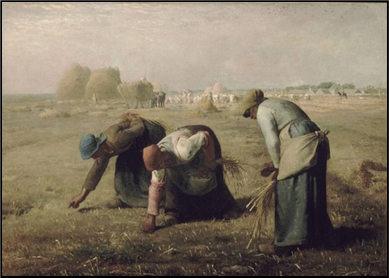 xxxxxJean François
Millet (1814-
xxxxxJean François
Millet (1814-
Including:
Jean François Millet,
Théodore Rousseau,
Camille Corot,The Hudson River
School and Frederick Edwin Church

Va-
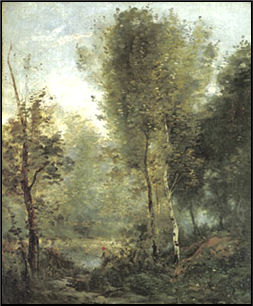 xxxxxA French artist who often painted at Barbizon but was
not a member of the school was Camille
Corot (1796-
xxxxxA French artist who often painted at Barbizon but was
not a member of the school was Camille
Corot (1796-
xxxxxHe was born in Paris, where his parents managed a fashionable dress shop. He worked for the family business for a while, but in 1822, at the age of 25, his father gave him a small allowance and he began training as a painter, the career of his own choice. He attended art classes in Rouen, but also taught himself a great deal by observing and sketching subjects out of doors. In 1825 he travelled to Rome and it was then that he fell in love with the Italian countryside and revealed his natural leaning towards classical order. He painted in the city and the surrounding countryside, and then visited Naples and the Island of Ischia before returning to France via Venice. His stay, which lasted for three years, produced some outstanding sketches and paintings, such as the Claudian Aqueduct, and his treatment of trees and cloud formation during this period showed the influence of the English landscape artist John Constable, whose works he had seen exhibited in Paris during the early 1820s. He returned to France determined to devote his whole life to painting.
xxxxxCorot settled
in Paris in 1828, and over the next six years produced some of his
finest landscapes, painted directly from nature. For much of the
time he worked in Normandy, at his family estate at Ville d’Avray
near Paris, or at Barbizon with his friends Millet, Rousseau and
Daubigny. In 1834 he made his second visit to Italy, visiting
Florence, Pisa and Genoa, and then travelled across Europe.
Throughout this period he produced a large number of small oil
sketches and drawings from nature, many of which came to be highly
regarded for their free brushwork and their masterly graduation 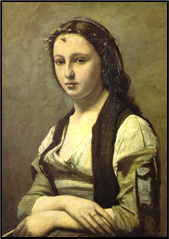 of
tone.
of
tone.
xxxxxDuring the winter months he worked in his studio, enlarging upon these sketches, but he also produced pictures with the annual Salon in mind, and these, pandering to the current taste for pictorial themes in the classical mould, often contained legendary or biblical figures. Two such works of the 1840s were Homer and the Shepherds and Christ in the Garden of Olives. And towards the end of his career he also painted a number of stunning portraits, among which was his famous Woman with a Pearl, completed in 1870 (illustrated).
xxxxxBy 1845 his talent had been widely recognised and, ten years later, when Napoleon III bought one of his paintings, Chariot: Recollections of Marcoussis, the commissions flooded in and the asking prices soared. In all he produced over 3,000 paintings. His major works included The Bridge of Narni, Dance of the Nymphs, and one of his last works, The Belfry of Douais (illustrated below). By the 1850s he was a wealthy man, but he continued his simple life as a painter, and used his money to assist struggling young artists and friends in need, such as the cartoonist Honoré Daumier. Such generosity towards others earned him widespread respect and the title of “Père Corot”. His Salon works apart, his fresh, spontaneous sketches, produced out of doors and focusing as they did on the sheer appearance of natural beauty, paved the way for Impressionism. Indeed, towards the end of his career he gave lessons to Camille Pissarro, one of the outstanding members of that opening movement in modern art.
xxxxxThe French
artist Camille Corot
(1796-
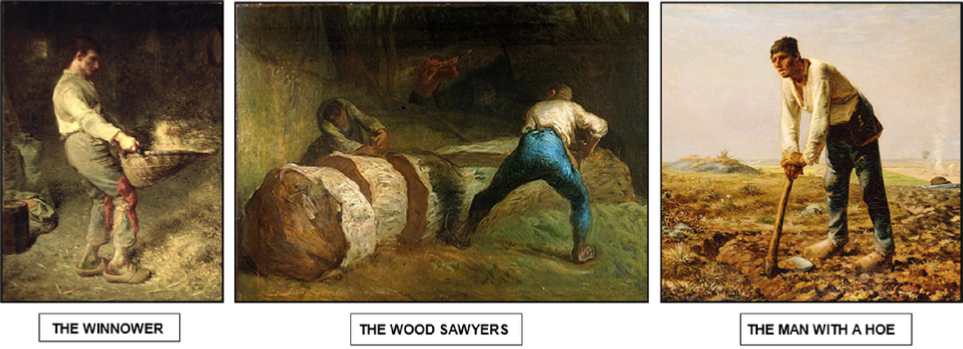
xxxxxIncidentally, in 1899 the American poet Edwin
Markham (1852-
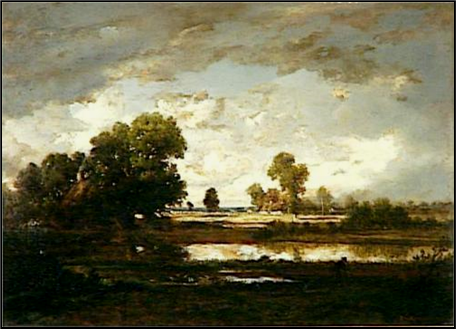 xxxxxA
devoted friend of Millet, the French painter Théodore
Rousseau (1812-
xxxxxA
devoted friend of Millet, the French painter Théodore
Rousseau (1812-
xxxxxRousseau’s works, among which were Under the Birches, Evening, Outskirts of the Forest of Fontainbleau, View of the Alps, and Pool with a Stormy Sky (illustrated above), were often sombre in tone, in keeping with his own moody temperament, but by the 1850s he had gained recognition as a prominent landscape artist, noted particularly for his painting of trees and clouds. In his early years he was Influenced by the English landscape painters John Constable and Richard Parkes Bonington, but his development of short, thick brushstrokes made him a forerunner of impressionism.

xxxxxIllustrated above are (left to right): Market place in Normandy, Fontainebleau Forest, Morning, and Sunset in the Auvergne.
xxxxxIncidentally, though many of Rousseau’s paintings were rejected in his early days, there were those who recognised his talent and collected his works. Among these was a French group that included the artist Eugène Delacroix, the poet Charles Baudelaire, and the romantic writer George Sand.
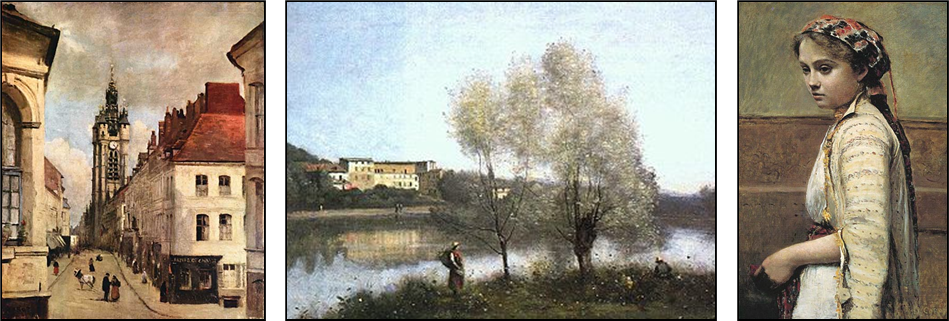
Illustrated here are (left to right): The Belfry of Douai, Ville d’Avray, and The Greek Girl.
xxxxxAnotherxartistic school of this period was the Hudson River School. Formed in the 1820s by a group of landscape artists living in the Catskill Mountain area of New York State, it was the first native school of painting and, being fiercely nationalistic, aimed to portray the beauty and grandeur of the American countryside. The work of its members was characterized by detailed observation and a romantic love of nature, and this style was later taken up by artists working in the West, where dramatic regions like the Rocky and Sierra mountains provided vistas of outstanding natural beauty.
xxxxxThexschool’s most prominent artist was Frederick
Edwin Church (1826-

xxxxxThe popularity of his work made him a wealthy man and, along with his wife, Isabella, he paid visits to both Europe and the Middle East. By 1876, however, Church was suffering from rheumatoid arthritis, and this seriously affected his output. He died in 1900 in his home in Locust Valley, New York, and was buried in his place of birth, the City of Hartford.


